67 - Uncommon Tumors of the Pleura
Editors: Shields, Thomas W.; LoCicero, Joseph; Ponn, Ronald B.; Rusch, Valerie W.
Title: General Thoracic Surgery, 6th Edition
Copyright 2005 Lippincott Williams & Wilkins
> Table of Contents > Volume I - The Lung, Pleura, Diaphragm, and Chest Wall > Section XIII - The Trachea > Chapter 79 - Compression of the Trachea by Vascular Rings
Chapter 79
Compression of the Trachea by Vascular Rings
Carl L. Backer
The phrase vascular ring refers to a group of congenital vascular anomalies of the aortic arch complex that form an anatomic ring that constricts and compresses the trachea or esophagus or both. Hommel, cited by Turner (1962), first described a vascular ring, a double aortic arch, in 1737. Almost all clinically significant vascular rings become symptomatic in infants or young children and initially present with airway obstruction from tracheal compression. Esophageal compression and obstruction usually become apparent later when solid foods are started.
The classification of vascular rings that is used today is based on specific anatomic features, particularly the location of the aortic arch. This classification scheme was endorsed by the Congenital Heart Surgery International Nomenclature and Database Project, as reported by the author and Mavroudis (2000). Table 79-1 represents the experience at Children's Memorial Hospital in Chicago and indicates the relative frequency of the different anomalies that presented for surgical intervention over the past 50 years. Some of these anomalies are anatomically complete rings, or true vascular rings; others are anatomically incomplete, or partial vascular rings, but are grouped with the true vascular rings because they present with similar pathophysiology and hence clinical symptoms. Complete tracheal rings are included because of their close association with pulmonary artery sling, and the similar respiratory symptoms.
Gross (1945) reported the first successful operation for a vascular ring when he divided a double aortic arch causing tracheal obstruction in a 1-year-old infant. Gross and Neuhauser (1948) also reported the first successful suspension of the innominate artery to the sternum for innominate artery compression syndrome in a 4-month-old infant with wheezing and respiratory distress.
Potts and colleagues (1954) coined the term pulmonary artery sling in their report of successful repair of that anomaly in a 5-month-old with intermittent attacks of dyspnea and cyanosis. Idriss and colleagues (1984) first reported the successful use of pericardium as a tracheoplasty technique in a 7-month-old with complete tracheal rings. These historical milestones are summarized in Table 79-2.
EMBRYOLOGY
Congdon (1922) reported an extensive experience with the embryonic development of the human aortic arch system, showing that six pairs of aortic arches connect the two primitive ventral and dorsal aortae (Fig. 79-1). Most portions of the first, second, and fifth arches regress. The third arches become the carotid arteries. A branch from the ventral bud of the sixth arch meets the lung bud to form the pulmonary artery. On the right side, the dorsal contribution to the sixth arch disappears; on the left, it persists as the ductus arteriosus.
The formation of a vascular ring depends on preservation or deletion of specific segments of the embryonic aortic arch complex. To help visualize this, Edwards (1948) proposed a schematic model with a double aortic arch system and bilateral ductus arteriosus. By convention, the location of the aortic arch is determined by its relationship to the trachea. In the normal arch formation, the right fourth arch regresses, leaving a left aortic arch system (i.e., apex of aortic arch to the left of the trachea). If both fourth arches persist, a double aortic arch is formed. If the left fourth arch
P.1083
regresses, a right aortic arch system is created (apex of aortic arch to the right of the trachea). This is schematically demonstrated in Fig. 79-2.
Table 79-1. Classification of Vascular Rings and Children's Memorial Hospital Experience, 1947 to 2001 | ||||||||||||||||||
|---|---|---|---|---|---|---|---|---|---|---|---|---|---|---|---|---|---|---|
| ||||||||||||||||||
Table 79-2. History of Vascular Ring Surgery | |||||||||||||||
|---|---|---|---|---|---|---|---|---|---|---|---|---|---|---|---|
|
CLINICAL FEATURES, DIAGNOSES, AND SURGICAL TREATMENT
Double Aortic Arch
A double aortic arch is the most common complete vascular ring that causes tracheoesophageal compression. Potts and associates (1948) noted that patients typically present in the first months of life with symptoms of stridor, respiratory distress, and a cough that sounds like a seal's bark. A simple cold may precipitate severe respiratory difficulty. The ascending aorta divides into two arches that pass around the trachea and esophagus and join posteriorly to form the descending aorta (see Fig. 79-2). I and my associates
P.1084
(1989) showed that in two-thirds of these infants, the right-sided (posterior) arch is dominant, and in one-third, the left-sided (anterior) arch is dominant. Rarely, the arches are of equal size (balanced arches). The carotid and subclavian arteries originate symmetrically and separately from each arch. The tight, constricting ring thus formed compresses the trachea and esophagus.
 |
Fig. 79-1. The embryonic aortic arches. Six pairs of aortic arches develop between the dorsal and ventral aortae. Areas that are shaded regress. The seventh intersegmental arteries migrate cephalad to form the subclavian arteries. From Lowe GM, Donaldson JS, Backer CL: Vascular rings: 10-year review of imaging. RadioGraphics 11:637, 1991. With permission. |
 |
Fig. 79-2. Aortic arch development. Beginning with the embryonic aortic arch, the first, second, and fifth arches involute to form Edwards' classic double aortic arch. If the development stops at this point, the child has a double aortic arch. If the right fourth arch involutes, a normal left arch is formed. If the left fourth arch involutes, a right aortic arch is formed. From Backer CL, Mavroudis C: Surgical approach to vascular rings. In Karp R, et al. (eds): Advances in Cardiac Surgery. Vol. 9. St. Louis: Mosby-Year Book, 1997, p. 31. With permission. |
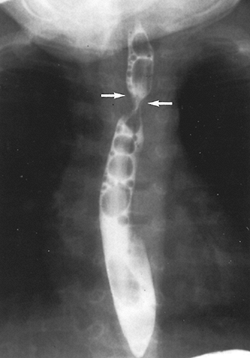 |
Fig. 79-3. Anteroposterior esophagogram of a 4-month-old boy who presented with stridor and was found to have a double aortic arch. From Backer CL, et al: Vascular anomalies causing tracheoesophageal compression. Review of experience in children. J Thorac Cardiovasc Surg 97:725, 1989. With permission. |
 |
Fig. 79-4. Contrast-enhanced computed tomographic scan of a 3-week-old girl presenting with severe stridor shows a double aortic arch, left arch dominant. The right arch was successfully divided through a left thoracotomy. The large arrow points to the dominant left (anterior) arch. The small arrow points to the smaller right (posterior) arch. |
The diagnosis can be suspected on examination of the chest radiograph because the location of the aortic arch in relation to the trachea is indeterminate. In addition, the tracheal air column often shows compression that is more prominent on the side of the dominant arch. Although for many years a barium esophagogram was the next diagnostic procedure of choice, currently either a computed tomographic (CT) scan with contrast or a magnetic resonance (MR) imaging scan is the best for surgical intervention. The double aortic arch on an anteroposterior esophagogram appears as bilateral indentations of unequal size that persist in location (Fig. 79-3). However, the barium esophagogram does not define the precise anatomy of the vascular ring. McLoughlin and co-workers (1981) have shown that CT scanning is very accurate in the identification of vascular anomalies of the aortic arch and great vessels. A double aortic arch is diagnosed with certainty when both limbs are patent and enhanced with the administration of contrast material (Fig. 79-4).
As described by Lowe and associates (1991), one clue to an arch anomaly, specifically a double aortic arch or a right aortic arch with retroesophageal subclavian artery and a ligamentum arteriosum, is the four artery sign. This is seen on sections cephalad to the aortic arch and consists of two dorsal subclavian arteries and two ventral carotid arteries spaced evenly around the trachea. The sign is present when the two dorsal subclavian arteries arise directly from the aorta and not from a brachiocephalic artery (Fig. 79-5).
 |
Fig. 79-5. Same infant as in Fig. 79-4. The small arrows point to the four brachiocephalic vessels; the large arrow points to the trachea. |
P.1085
MR imaging, as described by Van Son and associates (1994), demonstrates the arch and vessel anatomy. However, if the child moves there will be motion artifact, making the analysis difficult. Axial images provide the same information as CT without ionizing radiation or the need for intravenously administered contrast material. In addition, coronal and sagittal sections or images can be helpful in confusing cases. A disadvantage of MR imaging is the length of time required for the study and thus necessitating sedation. Currently the ultrafast CT scan with contrast is the test of choice. Cardiac catheterization is recommended now only for infants with associated congenital cardiac anomalies. Bronchoscopy is obtained sometimes as the initial study because of the presentation with stridor and shows external compression of the trachea.
All infants with double aortic arch should be operated on; a narrowed trachea, when further compromised by mucosal edema from even a mild upper respiratory infection, can cause hypoxic or apneic episodes. As Midulla and associates (1994) reported, these children are also at risk for aortic dissection. In addition, as Heck (1993) and Othersen (1996) and their colleagues have reported, improper management of respiratory obstruction with prolonged intubation and nasogastric tube irrigation may lead to catastrophic erosion of an arch into the esophagus.
Surgical approach is through a left thoracotomy, except in cases of associated intracardiac lesions, in which case simultaneous repair can be effected through a median sternotomy. The left thoracotomy can be performed with a muscle-sparing technique, elevating the serratus anterior and the latissimus dorsi and entering the thorax through the fourth intercostal space. The vascular ring caused by the double aortic arch is released by dividing the lesser of the two arches, usually where it inserts into the descending aorta (Fig. 79-6). The definition of which arch is smaller is best made on the preoperative CT or MR imaging. In
P.1086
30% to 40% of these patients, the site where the smaller arch inserts into the descending aorta will be atretic. After applying the vascular clamps, the anesthesiologist carefully checks the carotid and radial pulses on both sides to ensure blood flow is not interrupted. The arch is then divided between the vascular clamps, and the stumps are oversewn with Prolene sutures; simple ligation should not be done. The ligamentum arteriosum is also divided. Careful dissection is then performed around the trachea and esophagus to lyse any residual adhesive bands. The recurrent laryngeal and phrenic nerves are identified and protected throughout the procedure. The mediastinal pleura is not sutured closed because this could contribute to scar formation that might recreate the problems caused by the original vascular ring. For many years now, we have routinely not placed a chest tube, but have simply used a plastic suction catheter to evacuate pleural air and have pulled this out as the skin is closed. One technical factor that the surgeon should be aware of is that when the clamps are placed on the vascular ring before ring division, the ring is temporarily tightened by inserting the clamps into the area between the ring and the trachea and esophagus. Patients at times will have a drop in their oxygen saturation and may require increased ventilatory pressures to provide adequate ventilation during the time that the clamps are on the vascular ring.
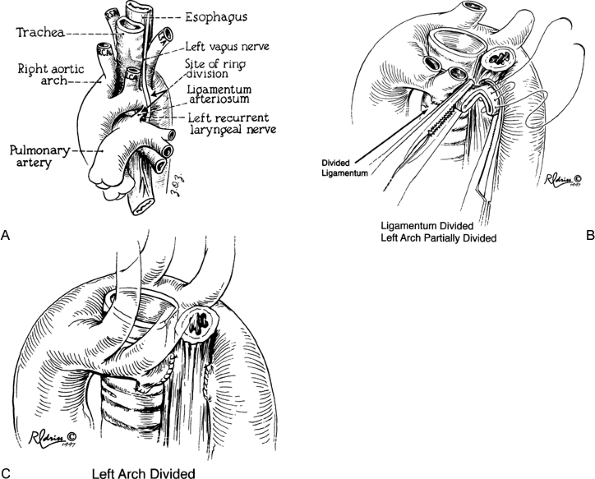 |
Fig. 79-6. A. Double aortic arch with right arch dominant. The vascular ring is divided at the sites shown by the arrows. LCA, left carotid artery; RCA, right carotid artery. From Backer CL, Idriss FS: Tracheoesophageal compressive syndromes of vascular origin: rings and slings. In Baue AE, et al. (eds): Glenn's Thoracic and Cardiovascular Surgery. 5th Ed. Norwalk, CT: Appleton-Century Crofts, 1991. With permission. B. Division of double aortic arch via left thoracotomy. A patent left aortic arch is being divided. There is a Potts ductus clamp on the proximal portion of the arch and a Castaneda clamp on the distal arch adjacent to the descending thoracic aorta. The vascular ring has been partially transected and a single polypropylene suture placed on the distal portion of the divided arch. The ligamentum has already been divided and oversewn. C. Completed repair with clamps removed. The stumps of the vascular rings have now separated nicely and the esophagus is clearly visible. From Backer CL, Mavroudis C: Surgical approach to vascular rings. In Karp R, et al. (eds): Advances in Cardiac Surgery. Vol. 9. St. Louis: Mosby-Year Book, 1997, p. 41. With permission. |
The postoperative care includes high humidity to loosen secretions, oxygen therapy when needed as monitored by pulse oximetry, vigorous chest physiotherapy, and nasopharyngeal suctioning. Results of surgical intervention are excellent, and no surgical mortality has resulted at Children's Memorial Hospital from a double aortic arch procedure since 1952. Most patients are discharged within 24 to 36 hours of the operation. As Nikaidoh and associates (1972) reported, some children have residual noisy breathing for 6
P.1087
months to 2 years, but in nearly all instances this gradually resolves.
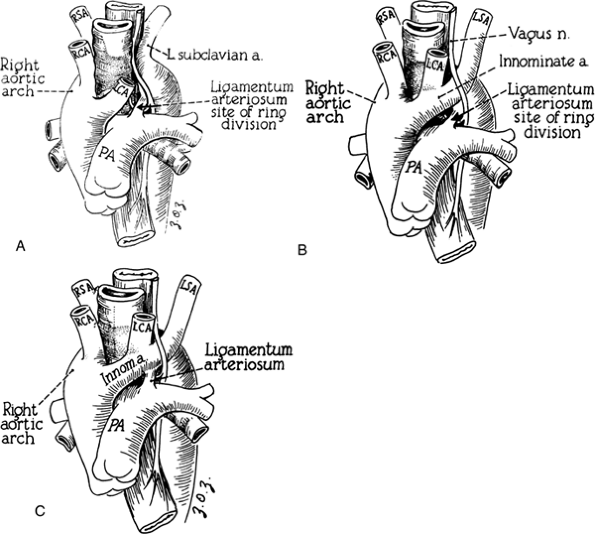 |
Fig. 79-7. A. With a right aortic arch and retroesophageal left subclavian artery, the ring is divided by dividing the ligamentum arteriosum, which extends from the aorta opposite the origin of the left subclavian artery to the left pulmonary artery (PA). B. With a right aortic arch and mirror-image branching of the great vessels, it is the ligamentum between the descending aorta and pulmonary artery that is divided to release the ring. C. With a right aortic arch and mirror-image branching, if the ligamentum connects the innominate artery to the pulmonary artery, a vascular ring is not formed, and the child would have no symptoms. |
Right Aortic Arch
Right aortic arch with a left ligamentum arteriosum completing the vascular ring is almost as common as a double aortic arch. The ring, however, is usually not as tight, and children typically present somewhat later in life (6 to 12 months of age). Symptoms are similar to those in infants with double aortic arch, with stridor, barky cough, and respiratory distress. In older children, dysphagia may be present. Some of these children eat very slowly and tend to be the last to leave the table because they have to carefully chew their food as a learned procedure to prevent choking. Embryologically, depending on the exact site or sites of interruption of the left fourth arch and the branching pattern to the left subclavian artery, left carotid artery, and ductus arteriosus, different configurations of right aortic arch are possible. Felson and Palayew (1963) showed that the two common variations are retroesophageal left subclavian artery (65%) and mirror-image branching (35%) (Fig. 79-7A,B). In either case it is the left ligamentum arteriosum between the descending aorta and the left pulmonary artery that completes the ring. Although D'Cruz and associates (1966) have reported that one-third of patients with tetralogy of Fallot and truncus arteriosus have a right aortic arch, our group did not find a reverse association with a specific cardiac defect when a vascular ring is formed by a right arch. In most infants with a cardiac defect and a right aortic arch, there is mirror-image branching with the ligamentum from the innominate artery to the pulmonary artery, so a vascular ring is not formed (Fig. 79-7C).
The diagnosis is suggested by the chest radiograph, which shows an aortic arch to the right of the tracheal air column. In children who have a ligamentum completing the ring, compression of the trachea by the aorta is often quite impressive. Barium esophagogram used to be the diagnostic procedure of choice (Fig. 79-8). However, using the same analysis as for a double aortic arch, either CT or MR imaging is best. This reveals the precise anatomy of the
P.1088
ring, including the identification of a Kommerell's diverticulum as part of the pathology. Chun and associates (1992) have emphasized the importance of an associated Kommerell's (1936) diverticulum. This diverticulum is embryologically a remnant of the left fourth aortic arch that did not undergo complete involution. The diverticulum may independently compress the esophagus or trachea. This aneurysmal dilatation should be resected if present and may necessitate transfer of the left subclavian artery to the left carotid artery. An example of an MR image in a patient with a right aortic arch, left ligamentum, and retroesophageal left subclavian artery is shown in Fig. 79-9.
 |
Fig. 79-8. Anteroposterior (A) and lateral (B) views of simultaneous esophagogram and aortogram in a patient with a right aortic arch and left ligamentum. The origin of the left subclavian artery is aneurysmal, forming a Kommerell's diverticulum. The combination of the tight ligamentum and the diverticulum (arrow) severely compresses the esophagus. In particular, the lateral film shows a classic deep posterior indentation from the large right arch. |
 |
Fig. 79-9. A 17-year-old patient with dysphagia. Magnetic resonance imaging shows a right aortic arch (small arrow) and a Kommerell's diverticulum (large arrow) at the origin of the left subclavian artery. From Backer CL, et al: Vascular anomalies causing tracheoesophageal compression. Review of experience in children. J Thorac Cardiovasc Surg 97:725, 1989. With permission. |
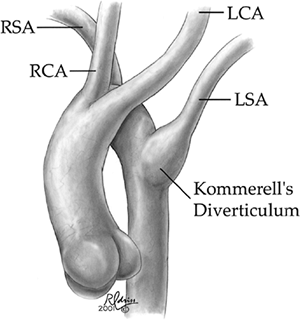 |
Fig. 79-10. The typical anatomy of a patient with a right aortic arch, retroesophageal left subclavian artery, and large Kommerell's diverticulum. The Kommerell's diverticulum is an embryologic remnant of the left fourth aortic arch. LCA/RCA, left/right carotid artery; LSA/RSA, left/right subclavian artery. From Backer CL, et al: Resection of Kommerell's diverticulum and left subclavian artery: transfer for recurrent symptoms after vascular ring division. Eur J Cardiothorac Surg 22:64, 2002. With permission. |
The surgical approach is through a left thoracotomy. After careful dissection and identification of the configuration of the aortic arch, the ligamentum arteriosum is identified as compressing the esophagus. The ring is released by dividing the ligamentum between vascular clamps and oversewing the stumps with Prolene suture. Any adhesive bands around the esophagus are lysed.
In the recent experience at our institution that was published by the author and colleagues (2002b), eight children required additional surgery because their vascular ring (ligamentum) was divided without addressing the associated Kommerell's diverticulum. All were symptomatic, with recurrent respiratory symptoms or recurrent dysphagia. All patients responded to reoperation with resection of the diverticulum and transfer of the left subclavian artery to the left carotid artery with resolution of airway symptoms (Figs. 74-10, 74-11, 74-12). Because of the success with these reoperations, the primary strategy for patients with a right aortic arch, left ligamentum, and Kommerell's diverticulum should be division of the ligamentum, resection of Kommerell's diverticulum, and left subclavian artery transfer.
A very rare group of children with a right aortic arch and left ligamentum have a left-sided descending thoracic aorta, the so-called circumflex aorta. Robotin and associates (1996) have described an aortic uncrossing operation for these rare patients (3 of 468 patients in their series of patients with vascular rings). This procedure is performed through a median sternotomy with cardiopulmonary bypass and hypothermic circulatory arrest. The aortic arch is mobilized, divided, and brought in front of the tracheobronchial tree, then reanastomosed end-to-side to the lateral aspect of the ascending aorta (Fig. 79-13). All three patients described by Robotin had prior ligamentum division via left thoracotomy.
The results of surgical intervention for right aortic arch with left ligamentum are very good. Like patients with a double aortic arch, it may take 6 to 12 months for resolution of airway symptoms.
Innominate Artery Compression Syndrome
Innominate artery compression syndrome results from anterior compression of the trachea by the innominate
P.1089
artery. There is a normal left aortic arch, but the innominate artery appears to originate somewhat more posteriorly and leftward on the aortic arch than usual. Ardito and associates (1980) have described how, as the artery then courses to the right, upward, and posterior to reach the thoracic outlet, it compresses the trachea anteriorly. These infants present with stridor, respiratory distress, cyanosis, and apnea with feeding. The infant may hold the head hyperextended to splint the trachea and improve breathing. Apnea or cyanosis may be precipitated by swallowing a bolus of food that presses on the soft posterior trachea with the innominate artery compressing the anterior trachea.
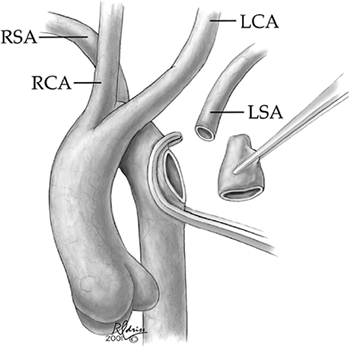 |
Fig. 79-11. A schematic illustration of the resection of a Kommerell's diverticulum through a left thoracotomy. There is a vascular clamp partially occluding the descending thoracic aorta at the origin of the Kommerell's diverticulum. The Kommerell's diverticulum has been completely resected. The clamp on the distal left subclavian artery is not illustrated. From Backer CL, et al: Resection of Kommerell's diverticulum and left subclavian artery: transfer for recurrent symptoms after vascular ring division. Eur J Cardiothorac Surg 22:64, 2002. With permission. |
Enthusiasm for this diagnosis increased in the late 1970s when bronchoesophagologists switched from local to general anesthesia for bronchoscopy. However, as experience with these patients was gained, the selection criteria for surgery became more stringent. The diagnosis is made with rigid bronchoscopy, which should demonstrate a pulsatile anterior compression of the trachea extending from left to right, with at least a 70% obstruction of the tracheal lumen. Anterior compression of the tracheal wall by the bronchoscope may compress the innominate artery and temporarily obliterate the right radial pulse. The diagnosis can be confirmed by CT scan, which will demonstrate flattening and obliteration of the tracheal lumen by the contrast-filled innominate artery (Fig. 79-14). Radionuclide studies for gastroesophageal reflux, sleep studies, and neurologic evaluation, including CT of the brain and electroencephalograms, should all be performed to rule out other causes of apnea. Barium esophagogram is normal in these infants.
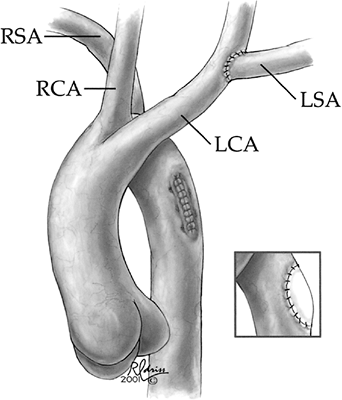 |
Fig. 79-12. The completed repair. The orifice where the Kommerell's diverticulum was resected is usually closed primarily, or, as shown in the inset, the orifice can be patched with polytetrafluoroethylene if necessary. The left subclavian artery has been implanted into the side of the left common carotid artery with fine running polypropylene suture. From Backer CL, et al: Resection of Kommerell's diverticulum and left subclavian artery: transfer for recurrent symptoms after vascular ring division. Eur J Cardiothorac Surg 22:64, 2002. With permission. |
When indicated, the management of compression of the trachea by the innominate artery classically has been with suspension of the innominate artery to the posterior aspect of the sternum, as originally described by Gross and Neuhauser (1948). Access via a small right submammary thoracotomy is now popular. The right lobe of the thymus is excised, taking care not to injure the right phrenic nerve. The innominate artery is secured with pledget-supported sutures to the posterior periosteum of the sternum to lift the innominate artery away from the trachea, simultaneously pulling the anterior tracheal wall open (Fig. 79-15). Hawkins and colleagues (1992) have described using a median sternotomy with division of the innominate artery and reimplantation into the ascending aorta at a site more to the right and anterior to the original site. This technique seems to sacrifice the active suspending mechanism on the tracheal wall provided by the classic technique and to have some risk of cerebrovascular accident.
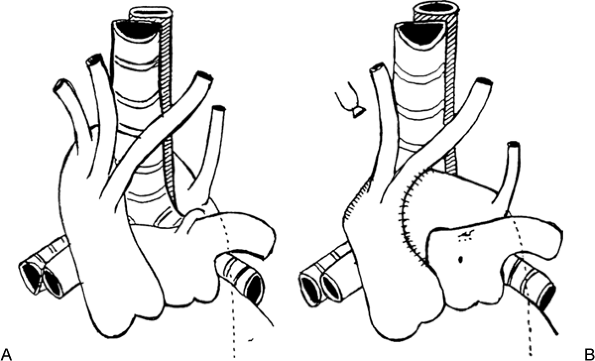 |
Fig. 79-13. A. The vascular anatomy present in a circumflex aorta. The right-sided aortic arch passes over the right main bronchus, then takes a retroesophageal course posterior to the trachea and joins the left-sided descending aorta superior to the carina. B. The aortic uncrossing procedure. This operation is performed through a median sternotomy with the use of cardiopulmonary bypass and circulatory arrest. The right subclavian artery is ligated and divided. The aortic arch is transected proximal to the origin of the right subclavian artery, mobilized, and reanastomosed to the left side of the ascending aorta and left carotid artery, in front of the trachea. From Robotin MC, et al: Unusual forms of tracheobronchial compression in infants with congenital heart disease. J Thorac Cardiovasc Surg 112:415, 1996. With permission. |
P.1090
At the Children's Memorial Hospital, the author and colleagues (1992a) reported suspension for 76 (now 84) children, with 2 (3%) undergoing reoperation, 71 (93%) relieved of symptoms, and no deaths related to the actual procedure. Innominate artery compression of the trachea historically has been well managed by innominate artery suspension through a right anterolateral thoracotomy, and I continue to recommend this approach. Jones and co-workers (1994) have also reported good results with standard innominate artery suspension.
Pulmonary Artery Sling
A pulmonary artery sling is a rare vascular anomaly in which the left pulmonary artery originates from the right pulmonary artery and encircles the right main-stem bronchus and distal trachea before coursing anterior to the esophagus and descending aorta to enter the hilum of the left lung (Fig. 79-16). This anomaly was first reported by Glaevecke and Doehle (1897) as a postmortem finding in a 7-month-old infant with severe respiratory distress. Sade and associates (1975) reported that embryologically, a pulmonary artery sling occurs during development of the lung bud when the left lung captures its arterial supply from derivatives of the right sixth aortic arch through capillaries caudad rather than cephalad to the developing tracheobronchial tree. The sling compresses and compromises the distal trachea and right main-stem bronchus. In addition, Cosentino and associates (1991) have shown that many of these infants will also have complete tracheal rings, a combination that Berdon and colleagues (1984) have appropriately referred to as the ring-sling complex.
Nearly all infants with pulmonary artery sling present within the first months of life with respiratory distress, particularly if there are associated complete tracheal rings. A chest radiograph may show unilateral hyperaeration of the right lung field. A barium esophagogram shows anterior compression of the esophagus on the lateral views. The barium swallow has a high false-negative rate. Diagnosis can be confirmed by cardiac echocardiogram, CT scan, or MR imaging. Angiography is no longer recommended, unless an
P.1091
associated congenital cardiac anomaly is suspected. Both CT and MR imaging will show clearly the left pulmonary artery originating from the right pulmonary artery, encircling the trachea, and coursing to the hilum of the left lung (Fig. 79-17). Currently, however, echocardiography is our diagnostic procedure of choice for pulmonary artery sling. Alboliras and associates (1996) reviewed two-dimensional and color flow Doppler to make this diagnosis, and noted the correct diagnosis was made in seven of seven patients. Many of these infants have a tenuous respiratory status, and it is much safer to do an echocardiogram at the bedside than to move the patient to the scanner. Bronchoscopy should be performed in all these infants to check for associated complete tracheal rings. In our experience, tracheal rings were found in 50% of patients with pulmonary artery sling. Tracheograms are indicated only in select cases and must be done with extreme caution to avoid further ventilatory compromise.
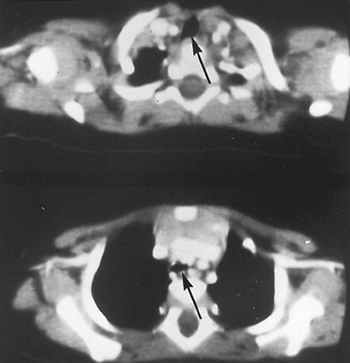 |
Fig. 79-14. Computed tomographic scan with contrast of an infant with innominate artery compression syndrome. The superior cut shows a normal-size trachea (arrow). The inferior cut shows the trachea (arrow) compressed by the innominate artery. |
 |
Fig. 79-15. Innominate artery suspension. Exposure is through a right submammary thoracotomy. Fixing the adventitia of the innominate artery to the posterior table of the sternum with pledgetted sutures pulls the innominate artery anteriorly and actively pulls the tracheal wall forward and opens it. Asc. Ao, ascending aorta. From Backer CL, Mavroudis C: Surgical approach to vascular rings. In Karp R, et al. (eds): Advances in Cardiac Surgery. Vol. 9. St. Louis: Mosby-Year Book, 1997, p. 49. With permission. |
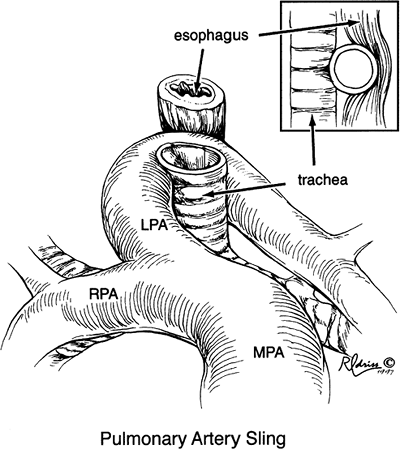 |
Fig. 79-16. Pulmonary artery sling. The left pulmonary artery (LPA) originates from the right pulmonary artery (RPA) and courses between the esophagus and trachea to reach the left lung. Inset shows lateral relationship of LPA to esophagus. It is this view that can be diagnostic on a barium swallow. MPA, main pulmonary artery. From Backer CL, Mavroudis CM: Surgical approach to vascular rings. In Karp R, et al. (eds): Advances in Cardiac Surgery. Vol. 9. St. Louis: Mosby-Year Book, 1997, p. 52. With permission. |
Surgical intervention should be undertaken as soon as the diagnosis is made because of the usual tenuous respiratory status. The first successful operation for pulmonary artery sling was performed by Potts and co-workers (1954) at Children's Memorial Hospital, through a right thoracotomy.
P.1092
Potts operated upon a 5-month-old infant who did not have an exact preoperative diagnosis but was felt to have vascular compression of the lower trachea and right bronchus by a vascular structure of some sort. He made the correct intraoperative diagnosis and considered several surgical alternatives, including right pneumonectomy, before deciding to transect the left pulmonary artery and reanastomose it to the main pulmonary artery anterior to the trachea. That particular child survived the surgery and is still alive; however, as Campbell and colleagues (1980) reported, the left pulmonary artery is occluded. Koopot and associates (1975) reported on several patients using the approach through a left thoracotomy and the technique described by Potts. This approach recently was reported by Pawade and colleagues (1992) to have good results (18 patients, 1 death), except in infants with associated tracheal stenosis.
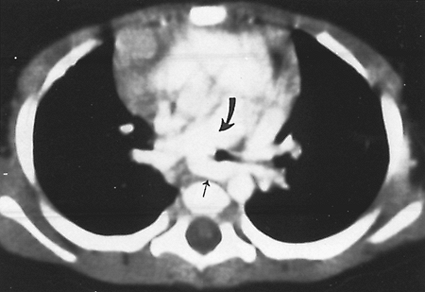 |
Fig. 79-17. Computed tomographic scan with contrast material from a 14-month-old girl with pulmonary artery sling and complete tracheal rings from the fourth tracheal ring to the carina. Curved arrow points to the main pulmonary artery. Small arrow points to the left pulmonary artery, which is wrapping around the trachea from right to left. Note that the tracheal lumen is small from complete tracheal rings. |
I and my associates (1992b, 1999) advocate an approach with median sternotomy and the use of extracorporeal circulation. This allows accurate ligation and division of the left pulmonary artery with implantation into the main pulmonary artery anterior to the trachea (Fig. 79-18). The operation can be performed without respiratory compromise, and enough time and care can be taken to ensure patency of the left pulmonary artery. Because nearly 50% of patients with pulmonary artery sling will have associated complete tracheal rings (the ring-sling complex), the median sternotomy approach allows simultaneous tracheoplasty. Since 1954, 31 patients with pulmonary artery sling have been operated upon at Children's Memorial Hospital. From 1985 to 2001, 23 infants had repair using a median sternotomy approach and cardiopulmonary bypass. Seventeen (55%) of these 31 children had associated complete tracheal rings. There has been no operative mortality, and there have been only three late deaths, all in patients having tracheoplasty for complete tracheal rings, with deaths occurring at 2.5 months, 7 months, and 2.5 years postoperatively. All left pulmonary arteries repaired on cardiopulmonary bypass are patent, and the mean percentage blood flow to the left lung by nuclear scan is 35%.
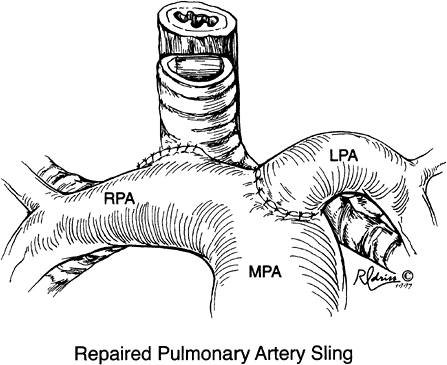 |
Fig. 79-18. Operative technique. Repair is performed by transecting the left pulmonary artery (LPA) at its origin from the right pulmonary artery (RPA) and anastomosing the LPA to the main pulmonary artery (MPA) anterior to the trachea at a site that approximates the usual anatomic configuration. From Backer CL, Mavroudis CM: Surgical approach to vascular rings. In Karp R, et al. (eds): Advances in Cardiac Surgery. Vol. 9. St. Louis: Mosby-Year Book, 1997, p. 54. With permission. |
Complete Tracheal Rings
As illustrated in Fig. 79-19, when the child has complete tracheal rings there is congenital absence of the membranous trachea, causing the cartilage to be circumferential. This causes tracheal stenosis, which often leads to severe respiratory distress in infancy. Benjamin and associates (1981) reported that medical management of this lesion is associated with a 43% mortality rate. Cantrell and Guild (1964) classified these patients into three categories: segmental stenosis, funnellike stenosis, and generalized hypoplasia. Although the number of rings and extent of the stenosis can be variable, most of our patients have had complete tracheal rings from one or two rings below the cricoid extending nearly to the carina. This diagnosis and the extent of involvement are established by rigid bronchoscopy. Often the bronchoscope itself will not pass through the stenosis, only the fine telescope.
Surgical options for the management of children with long-segment congenital tracheal stenosis from complete
P.1093
tracheal rings include pericardial patch tracheoplasty, cartilage tracheoplasty, slide tracheoplasty, tracheal homograft, and tracheal autograft. At Children's Memorial Hospital from 1982 to 2001, 28 patients have had pericardial tracheoplasty, 2 have undergone slide tracheoplasty, 9 have had resection of short segments of complete rings, and 15 have had repair using a free tracheal autograft. Nineteen of these patients (35%) had simultaneous pulmonary artery sling repair. Thirteen patients (24%) had simultaneous intracardiac repair of tetralogy of Fallot, including repair of a ventricular septal defect in four, repair of a complete atrioventricular canal in two, and correction of a double-outlet right ventricle, pulmonary atresia, and atrial septal defect. The current approach by our group is to use the tracheal autograft, supplemented with pericardium if necessary.
 |
Fig. 79-19. Complete tracheal rings causing long-segment congenital tracheal stenosis from the third tracheal ring to the carina. The membranous portion of the trachea is absent and the cartilages are circumferential. This patient has an associated tracheal right upper lobe bronchus. From Backer CL, Mavroudis CM: Surgical approach to vascular rings. In Karp R, et al. (eds): Advances in Cardiac Surgery. Vol. 9. St. Louis: Mosby-Year Book, 1997, p. 56. With permission. |
The technique of pericardial tracheoplasty was first described by Idriss and associates (1984). The approach is through a median sternotomy, and cardiopulmonary bypass is used for respiratory support. Bronchoscopy is used to guide an anterior incision in the trachea, which is extended proximal and distal to the complete tracheal rings. The trachea is patched open with an autologous pericardial patch anchored with interrupted 6-0 Vicryl sutures (Fig. 79-20). The patch is usually 1.5 to 2.0 cm wide and extends the length of the stenosis. The patch is stented open with an endotracheal tube for 7 to 10 days. Cosentino (1991) reported intermediate results, and Dunham and associates (1994), updated recently by the author and colleagues (2001), discussed the role of postoperative bronchoscopy to remove secretions and granulation tissue and perform dilation as needed. Cheng and associates (1997) reported complete re-epithelization of the graft site with ciliated pseudostratified columnar epithelium, suggesting the likelihood of normal mucociliary flow.
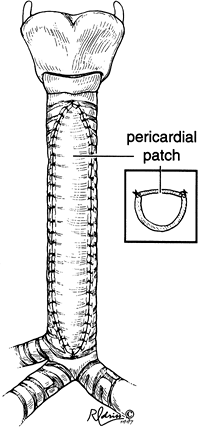 |
Fig. 79-20. Completed pericardial patch tracheoplasty augments the trachea anteriorly, opening the tracheal lumen significantly, as show in the inset. From Backer CL, Mavroudis CM: Surgical approach to vascular rings. In Karp R, et al. (eds): Advances in Cardiac Surgery. Vol. 9. St. Louis: Mosby-Year Book, 1997, p. 57. With permission. |
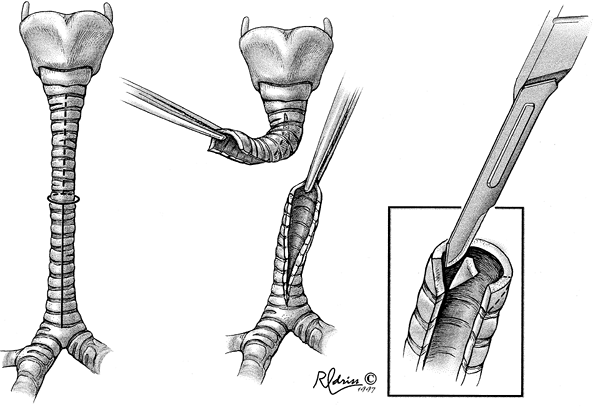 |
Fig. 79-21. The trachea is transected at the midpoint of the complete tracheal rings. The upper trachea is opened posteriorly; the lower trachea is opened anteriorly. The corners of the two tracheal ends are trimmed. Copyright Rashid Idriss. Reprinted with permission. |
P.1094
Our group has used the pericardial patch technique in 28 patients, with two early and four late deaths. One early death was from patch dehiscence and mediastinitis. The other was related to complications of postoperative extracorporeal membrane oxygenation. Three late deaths were related to residual or recurrent airway stenosis, and one to pulmonary hypertension. I and my colleagues (1997) reported that six of these patients required surgical revision, four with cartilage grafts and two with pericardium. As Furman and associates (1999) reported, three of these patients have required seven Palmaz stents. These balloon-expandable metallic stents were placed in the distal trachea or proximal bronchi with a bronchoscope under fluoroscopic guidance as originally described by Filler and colleagues (1995).
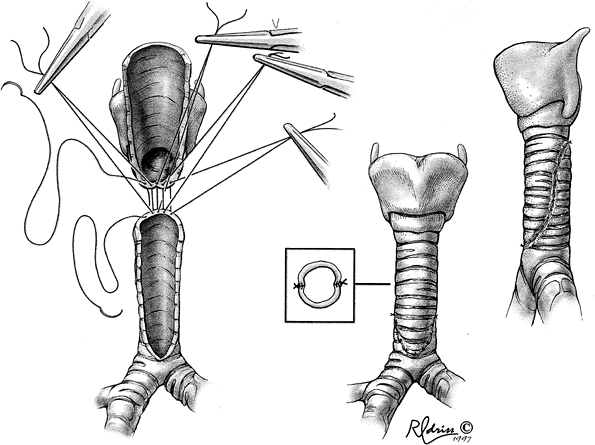 |
Fig. 79-22. Anastomosis between upper and lower trachea is performed with interrupted polydioxanone surgical (PDS) or Vicryl sutures (Ethicon, Somerville, NJ, U.S.A.). The length of the trachea has been reduced by almost half; the luminal diameter has been increased by four. Copyright Rashid Idriss. Reprinted with permission. |
The slide tracheoplasty was first described by Tsang and associates (1989), and was modified by Grillo (1994). A median sternotomy approach with the use of cardiopulmonary bypass is a superb alternative in children. The midportion of the trachea is identified bronchoscopically, and then the trachea is transected at this site. The lower trachea is opened anteriorly, and the upper trachea is opened posteriorly (Fig. 79-21). The two tracheal openings then slide, one on top of the other, after trimming the corners of the transected trachea. The two are anastomosed with interrupted Vicryl sutures (Fig. 79-22). This creates a trachea that is one-half as long as the original but has four times the diameter. Of course, the patient still has complete circumferential tracheal rings. Dayan and colleagues (1997) reported
P.1095
our results using this technique in two infants. One child did very well and was discharged at 18 days; the other had considerable growth of granulation tissue and severe tracheomalacia requiring a stent, and eventually died 4 months postoperatively. Grillo and associates (2002) have reported eight consecutive patients undergoing successful slide tracheoplasty.
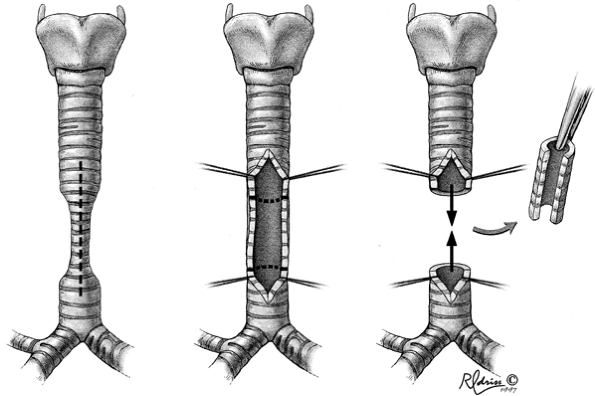 |
Fig. 79-23. Tracheal autograft technique. The lower trachea is incised anteriorly through 12 tracheal rings (8 complete rings). A 1.5-cm segment of trachea is excised, essentially the extent of the complete tracheal rings. Copyright Rashid Idriss. Reprinted with permission. |
Because of the high reoperation rate after pericardial tracheoplasty and mixed results with the slide tracheoplasty, our group developed a new operation that the author and co-workers (1998) labeled the tracheal autograft technique. Our group had noted that in children with complete tracheal rings the trachea is frequently longer than normal. Because of this, a pericardial tracheoplasty may result in an excessively long patch that does not have intrinsic support. A modification of the operation now uses cryopreserved homograft for repair of complete tracheal rings, as reported by Jacobs and associates (1996b), because the portions of trachea excised look just like the piece of homograft.
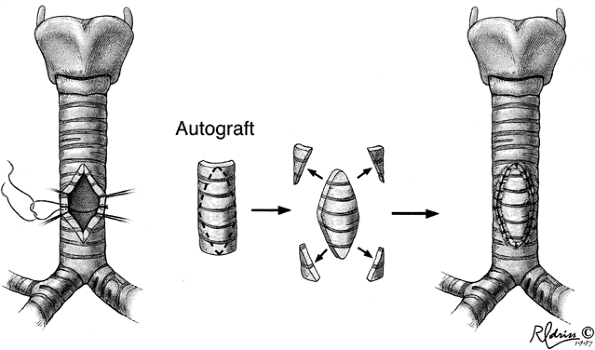 |
Fig. 79-24. The two cut ends of the trachea are anastomosed posteriorly with interrupted sutures. The corners of the autograft are trimmed so the autograft fits in the remaining anterior tracheal opening, where it is sutured in place. Copyright Rashid Idriss. Reprinted with permission. |
The technique again employs a median sternotomy approach with the use of cardiopulmonary bypass for respiratory support during the tracheal repair. The trachea is incised anteriorly though the extent of the stenosis (Fig. 79-23). A segment of trachea (1.3 to 2.2 cm) is excised, generally in the midportion of the trachea. The trachea is then reapproximated posteriorly (Fig. 79-24) with interrupted Vicryl sutures. The portion of trachea that was resected is brought in anteriorly as a free autograft. The corners of the autograft are trimmed, and it is sutured in place with interrupted Vicryl sutures. In a patient like the one illustrated, this completes the repair. In a child with longer stenosis, the autograft is used as a distal patch at the critical junction of the carina and left and right main-stem bronchus. The remaining opening in the upper trachea is augmented with a pericardial patch (1.5 cm to 3.0 cm in length).
P.1096
Since January 1996, as reported by the author and associates (2002a), we have used this technique in 15 infants (mean age 6 months). Ten were completed with the autograft alone; five required pericardial augmentation. There was one early death (7% early mortality) in a patient with tetralogy of Fallot who required extracorporeal membrane oxygenation support postoperatively. There was one late death (7% late mortality) in a patient who required an aortic homograft rescue procedure for a failed autograft (mediastinitis). Three patients required temporary tracheostomies.
Tracheal resection was performed through a median sternotomy with the use of cardiopulmonary bypass in nine patients. Median age was 4 months, and the mean number of tracheal rings excised was five rings (range two to eight rings). There was one late death secondary to liver failure awaiting liver transplantation. Mean hospital stay was 14 days. Wright and associates (2002) have demonstrated in a large series that resection of more than 30% of the trachea is more likely to result in anastomotic failure. We agree with that assessment and convert to a tracheal autograft technique if more than six to eight rings (30% of a trachea that normally has 18 to 22 total rings) require resection.
As mentioned earlier, European surgeons have reported using cadaveric treated homograft for congenital tracheal stenosis. Jacobs and colleagues (1996b) reported the use of cadaveric trachea that was harvested fresh, fixed in formalin, washed in thimerosal, and stored in acetone. The stenosed trachea was patched open with the tracheal homograft, placed over a temporary silicone rubber intraluminal stent. Jacobs and colleagues (1996a) reported on 24 children (mean age 8 years), with 20 survivors, of whom 16 are free of airway symptoms. Six of these patients had long-segment congenital tracheal stenosis, had prior tracheal operation, and were approached with a median sternotomy. The technique was successful in three of these children. Jacobs and associates (1999) recently updated this experience.
Aberrant Right Subclavian Artery
A left aortic arch with aberrant origin of the right subclavian artery from the descending thoracic aorta may cause posterior indentation of the esophagus (Fig. 79-25). Gross (1946) described this as the cause of dysphagia lusoria. Abbott (1936) reported that this is the most common vascular anomaly of the aortic arch system, occurring in 0.5% of humans. As Beabout and associates (1964) confirmed, however, it is usually not a source of symptoms severe enough to cause surgical intervention, unless there is aneurysmal dilatation of the subclavian origin. In adults, however, the base of the aberrant right subclavian artery may become dilated and aneurysmal, compressing the esophagus and causing symptoms of dysphagia. In that case the right subclavian artery should be divided, the aneurysm resected, and the right subclavian artery implanted into the aorta or carotid artery.
Pifarre and associates (1971) described this operation as a one-stage procedure with a left thoracotomy approach. More recently, Van Son and associates (1990) have recommended a surgical approach through a right thoracotomy. Esposito and associates (1988) found only 26 cases of aneurysm of an aberrant subclavian artery in the world literature, and only 16 patients had been operated on. They recommended an initial approach through a right cervical incision to divide the right subclavian distal to the aneurysmal dilatation and anastomosis of the distal end to the right carotid artery to preserve blood flow to the distal distribution of the artery. The patient is then placed in a right lateral decubitus position, and the aneurysm is excised through a left thoracotomy approach. These authors believe this approach obviates the possible complications of upper limb ischemia, cerebral embolization, and intraoperative hemorrhage.
Rare Vascular Rings
A cervical aortic arch may ascend into the neck and compress the trachea and esophagus. An anomalous left carotid artery may compress the trachea as it courses from right to left across the trachea. Whitman and associates (1982) reported
P.1097
that a left aortic arch with right-sided ligamentum and right-sided descending aorta is another unusual cause of tracheoesophageal compression. Watanabe and associates (1995) noted that this has been reported approximately 19 times in the world literature. This is one of the very rare vascular rings that, as McFaul and associates (1981) reported, may necessitate a right thoracotomy for successful correction. These infants often have associated cardiac anomalies, such as absent left pulmonary artery, ventricular septal defect, tetralogy of Fallot, and transposition of the great arteries, as noted by Park (1976), and the diagnosis is made by cardiac catheterization. The esophagogram also has a very distinctive appearance, with extrinsic indentation in the upper left posterior aspect of the esophagus at the level of the second thoracic vertebra.
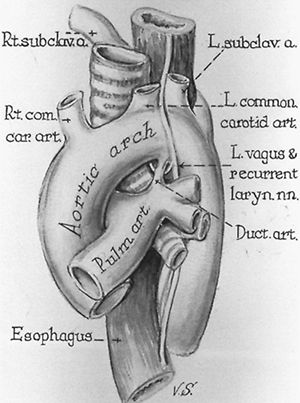 |
Fig. 79-25. Aberrant right subclavian artery originating as the last branch from the aortic arch. The artery courses posterior to the esophagus up to the right arm. From Idriss FS, et al: Surgery for vascular anomalies causing obstruction of the trachea and esophagus. In Tucker BL, Lindesmith GG (eds): Congenital Heart Disease. New York: Grune & Stratton, 1979, p. 125. With permission. |
Our group, as reported by Dodge-Khatami and associates (1999), encountered one patient (5 months old) with a right aortic arch and a right ligamentum compressing the right main bronchus. This child also had absence of the left pulmonary artery, requiring division of the ligamentum through a median sternotomy approach because of severe hyperinflation and blebs of the right lung.
Binet and colleagues (1978) described a single case report of a ductus arteriosus traversing from the right pulmonary artery to the descending aorta between the trachea and esophagus with an aberrant right subclavian artery. The ductus was compressing the trachea and right bronchus in a manner analogous to pulmonary artery sling.
Ben-Shachar and associates (1985) reported a hemitruncal sling creating a vascular ring. The right pulmonary artery originated from the ascending aorta and coursed in a dorsocranial direction, wrapping around the trachea.
VIDEO-ASSISTED THORACOSCOPIC SURGERY
There have recently been reports of using video-assisted thoracoscopic surgery (VATS) for the division of vascular rings. This has occurred as an extension of the use of VATS for patent ductus arteriosus ligation as reported by Laborde and colleagues (1993). Burke and associates (1995) reported the use of VATS for eight patients with vascular rings. Anatomy of the rings included double aortic arch with an atretic left arch (three patients) and right aortic arch, left ligamentum arteriosum (five patients). Three patients (37.5%) required a thoracotomy to complete the procedure. The median operating time was 4 hours, and the median hospital stay was 3 days. The mean hospital stay of our vascular ring patients has been 1 day, so I do not believe that the VATS technique is a sufficient improvement to recommend its use. It is interesting to note there were no patients in Burke's series with a patent arch. A real concern for the patient with a patent arch is that once the clips are applied and the ring divided, the two stumps retract because of the tension on the ring. The posterior stump often retracts into the mediastinum, and if the clip should slip off, the risk of hemorrhage is great. It is not always possible to tell externally whether a segment of the ring is atretic or patent. This is another reason not to use VATS for these patients.
REFERENCES
Abbott ME: Atlas of Congenital Cardiac Disease. New York: American Heart Association, 1936, p. 16.
Alboliras ET, et al: Pulmonary artery sling: diagnostic and management strategy. Pediatrics 98:530A, 1996.
Ardito JM, et al: Innominate artery compression of the trachea in infants with reflex apnea. Ann Otol Rhinol Laryngol 89:401, 1980.
Backer CL, Mavroudis C: Congenital Heart Surgery Nomenclature and Database Project: vascular rings, tracheal stenosis, pectus excavatum. Ann Thorac Surg 69:S308, 2000.
Backer CL, Holinger LD, Mavroudis C: Invited letter concerning: innominate artery compression division and reimplantation versus suspension. J Thorac Cardiovasc Surg 103:817, 1992a.
Backer CL, Mavroudis C, Holinger LD: Repair of congenital tracheal stenosis. Semin Thorac Cardiovasc Surg Pediatr Card Surg Annu 5:173, 2002a.
Backer CL, et al: Vascular anomalies causing tracheoesophageal compression. Review of experience in children. J Thorac Cardiovasc Surg 97: 725, 1989.
Backer CL, et al: Pulmonary artery sling. Results of surgical repair in infancy. J Thorac Cardiovasc Surg 103:683, 1992b.
Backer CL, et al: Reoperation after pericardial patch tracheoplasty. J Pediatr Surg 32:1108, 1997.
Backer CL, et al: Repair of congenital tracheal stenosis with a free tracheal autograft. J Thorac Cardiovasc Surg 115:869, 1998.
Backer CL, et al: Pulmonary artery sling: results with median sternotomy, cardiopulmonary bypass, and reimplantation. Ann Thorac Surg 67:1738, 1999.
Backer CL, et al: Tracheal surgery in children: an 18-year review of four techniques. Eur J Cardiothorac Surg 19:777, 2001.
Backer CL, et al: Resection of Kommerell's diverticulum and left subclavian artery: transfer for recurrent symptoms after vascular ring division. Eur J Cardiothorac Surg 22:64, 2002b.
Beabout JW, Stewart JR, Kincaid OW: Aberrant right subclavian artery, dispute of commonly accepted concepts. AJR Am J Roentgenol 92:855, 1964.
Benjamin B, Pitkin J, Cohen D: Congenital tracheal stenosis. Ann Otol Rhinol Laryngol 90:364, 1981.
Ben-Shachar G, et al: Hemitruncal sling: a newly recognized anomaly and its surgical correction. J Thorac Cardiovasc Surg 90:146, 1985.
Berdon WE, et al: Complete cartilage-ring tracheal stenosis associated with anomalous left pulmonary artery: the ring-sling complex. Radiology 152:57, 1984.
Binet JP, et al: Ductus arteriosus sling: report of a newly recognised anomaly and its surgical correction. Thorax 33:72, 1978.
Burke RP, et al: Video-assisted thoracoscopic surgery for congenital heart disease. J Thorac Cardiovasc Surg 109:499, 1995.
Campbell CD, et al: Aberrant left pulmonary artery (pulmonary artery sling): successful repair and 24 year follow-up report. Am J Cardiol 45: 316, 1980.
Cantrell JR, Guild HG: Congenital stenosis of the trachea. Am J Surg 108: 297, 1964.
Cheng ATL, et al: Histopathologic changes after pericardial patch tracheoplasty. Arch Otolaryngol Head Neck Surg 123:1069, 1997.
Chun KF, et al: Diagnosis and management of congenital vascular rings: a 22-year experience. Ann Thorac Surg 53:597, 1992.
Congdon ED: Transformation of the aortic arch system during the development of the human embryo. Contrib Embryol 14:47, 1922.
Cosentino CM, et al: Pericardial patch tracheoplasty for severe tracheal stenosis in children: intermediate results. J Pediatr Surg 26:879, 1991.
Dayan SH, et al: Slide tracheoplasty in the management of congenital tracheal stenosis. Ann Otol Rhinol Laryngol 106:914, 1997.
D'Cruz IA, et al: Right-sided aorta. Br Heart J 28:722, 1966.
Dodge-Khatami A, et al: Right aortic arch, right ligamentum, absent left pulmonary artery: a rare vascular ring. Ann Thorac Surg 67:1472, 1999.
P.1098
Dunham ME, et al: Management of severe congenital tracheal stenosis. Ann Otol Rhinol Laryngol 103:351, 1994.
Edwards JE: Anomalies of derivatives of aortic arch system. Med Clin North Am 32:925, 1948.
Esposito RA, et al: Surgical treatment for aneurysm of aberrant subclavian artery based on a case report and review of the literature. J Thorac Cardiovasc Surg 95:888, 1988.
Felson B, Palayew MJ: The two types of right aortic arch. Radiology 81:745, 1963.
Filler RM, et al: The use of expandable metallic airway stents for tracheobronchial obstruction in children. J Pediatr Surg 30:1050, 1995.
Furman RH, et al: The use of balloon-expandable metallic stents in the treatment of pediatric tracheomalacia and bronchomalacia. Arch Otolaryngol Head Neck Surg 125:203, 1999.
Glaevecke, Doehle: Ueber eine seltene angeborene Anomalie der Pulmonalarterie. Munch Med Wochenschr 44:950, 1897.
Grillo HC: Slide tracheoplasty for long-segment congenital tracheal stenosis. Ann Thorac Surg 58:613, 1994.
Grillo HC, et al: Management of congenital tracheal stenosis by means of slide tracheoplasty or resection and reconstruction, with long-term follow-up of growth after slide tracheoplasty. J Thorac Cardiovasc Surg 123:145, 2002.
Gross RE: Surgical relief for tracheal obstruction from a vascular ring. N Engl J Med 233:586, 1945.
Gross RE: Surgical treatment for dysphagia lusoria. Ann Surg 124:532, 1946.
Gross RE, Neuhauser EBD: Compression of the trachea by an anomalous innominate artery: an operation for its relief. Am J Dis Child 75:570, 1948.
Hawkins JA, Bailey WW, Clark SM: Innominate artery compression of the trachea: treatment by reimplantation of the innominate artery. J Thorac Cardiovasc Surg 103:678, 1992.
Heck HA Jr, et al: Esophageal-aortic erosion associated with double aortic arch and tracheomalacia: experience with 2 infants. Tex Heart Inst J 20:126, 1993.
Idriss FS, et al: Surgery for vascular anomalies causing obstruction of the trachea and esophagus. In Tucker BL, Lindesmith GG (eds): Congenital Heart Disease. New York: Grune & Stratton, 1979, p. 125.
Idriss FS, et al: Tracheoplasty with pericardial patch for extensive tracheal stenosis in infants and children. J Thorac Cardiovasc Surg 88:527, 1984.
Jacobs JP, et al: Pediatric tracheal homograft reconstruction: a novel approach to complex tracheal stenoses in children. J Thorac Cardiovasc Surg 112:1549, 1996a.
Jacobs JP, et al: Successful complete tracheal resection in a three-month-old infant. Ann Thorac Surg 61:1824, 1996b.
Jacobs JP, et al: Tracheal allograft construction. The total North American and worldwide pediatric experiences. Ann Thorac Surg 68:1043, 1999.
Jones DT, Jonas RA, Healy GB: Innominate artery compression of the trachea in infants. Ann Otol Rhinol Laryngol 103:347, 1994.
Kommerell B: Verlagerung des Osophagus durch eine abnorm verlaufende Arteria Subclavia Dextra (Arteria Lusoria). Fortsch Geb Rontgenstr 54:590, 1936.
Koopot R, Nikaidoh H, Idriss FS: Surgical management of anomalous left pulmonary artery causing tracheobronchial obstruction. Pulmonary artery sling. J Thorac Cardiovasc Surg 69:239, 1975.
Laborde F, et al: A new video-assisted thoracoscopic surgical technique for interruption of patent ductus arteriosus in infants and children. J Thorac Cardiovasc Surg 105:278, 1993.
Lowe GM, Donaldson JS, Backer CL: Vascular rings: 10-year review of imaging. RadioGraphics 11:637, 1991.
McFaul R, Millard P, Nowicki E: Vascular rings necessitating right thoracotomy. J Thorac Cardiovasc Surg 82:306, 1981.
McLoughlin MJ, et al: Computed tomography in congenital anomalies of the aortic arch and great vessels. Radiology 138:399, 1981.
Midulla PS, et al: Aortic dissection involving a double aortic arch with a right descending aorta. Ann Thorac Surg 58:874, 1994.
Nikaidoh H, Riker WL, Idriss FS: Surgical management of vascular rings. Arch Surg 105:327, 1972.
Othersen HB Jr, et al: Aortoesophageal fistula and double aortic arch: two important points in management. J Pediatr Surg 31:594, 1996.
Park SC, et al: Left aortic arch with right descending aorta and right ligamentum arteriosum. A rare form of vascular ring. J Thorac Cardiovasc Surg 71:779, 1976.
Pawade A, et al: Pulmonary artery sling. Ann Thorac Surg 54:967, 1992.
Pifarre R, Dieter RA Jr, Niedballa RG: Definitive surgical treatment of the aberrant retroesophageal right subclavian artery in the adult. J Thorac Cardiovasc Surg 61:154, 1971.
Potts WJ, Gibson S, Rothwell R: Double aortic arch: report of two cases. Arch Surg 57:227, 1948.
Potts WJ, Holinger PH, Rosenblum AH: Anomalous left pulmonary artery causing obstruction to right main bronchus: report of a case. JAMA 155: 1409, 1954.
Robotin MC, et al: Unusual forms of tracheobronchial compression in infants with congenital heart disease. J Thorac Cardiovasc Surg 112:415, 1996.
Sade RM, et al: Pulmonary artery sling. J Thorac Cardiovasc Surg 69:333, 1975.
Tsang V, et al: Slide tracheoplasty for congenital funnel-shaped tracheal stenosis. Ann Thorac Surg 48:632, 1989.
Turner W: On irregularities of the pulmonary artery, arch of the aorta and the primary branches of the arch with an attempt to illustrate their mode of origin by a reference to development. Br Foreign Med Chir Rev 30: 173, 1962.
Van Son JAM, et al: Anatomic support of surgical approach of anomalous right subclavian artery through a right thoracotomy. J Thorac Cardiovasc Surg 99:1115, 1990.
Van Son JA, et al: Imaging strategies for vascular rings. Ann Thorac Surg 57:604, 1994.
Watanabe M, et al: Left aortic arch with right descending aorta and right ligamentum arteriosum associated with d-TGA and large VSD: surgical treatment of a rare form of vascular ring. J Pediatr Surg 30:1363, 1995.
Whitman G, Stephenson LW, Weinberg P: Vascular ring: left cervical aortic arch, right descending aorta, and right ligamentum arteriosum. J Thorac Cardiovasc Surg 83:311; 1982.
Wright CD, et al: Pediatric tracheal surgery. Ann Thorac Surg 74;308, 2002.
EAN: 2147483647
Pages: 203